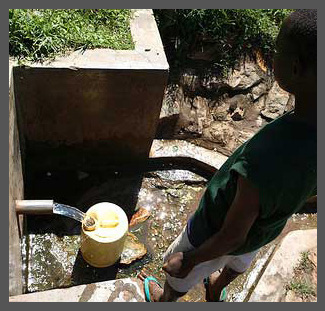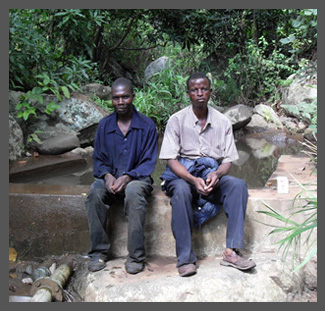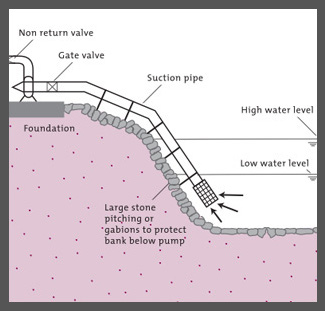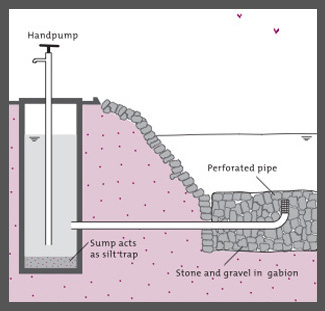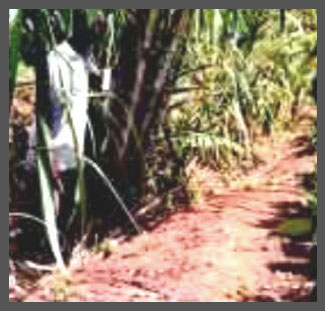Difference between revisions of "Water Portal / Rainwater Harvesting / Surface water"
(→Surface water links) |
|||
| (23 intermediate revisions by 4 users not shown) | |||
| Line 1: | Line 1: | ||
| − | {{Language-box|english_link=Water Portal / Rainwater Harvesting / Surface water |french_link=Eaux superficielles | spanish_link=Aguas superficiales | malayalam_link=ഉപരിതല ജലം | korean_link= | + | {{Language-box|english_link=Water Portal / Rainwater Harvesting / Surface water |french_link=Eaux superficielles | spanish_link=Aguas superficiales | hindi_link=वाटर पोर्टल / वर्षाजल संचयन / सतही जल | malayalam_link=ഉപരിതല ജലം | swahili_link=coming soon | korean_link=지표수 | chinese_link=地表水(中文) | indonesian_link=Panen Air Hujan / Air Permukaan | japanese_link= 地表水 }} |
Rainwater that is not captured directly, used by agriculture, or absorbed into the ground becomes surface water. '''Surface water''' harvesting includes all systems that collect and conserve surface runoff after a rainstorm or in intermittent streams, rivers, or wetlands for storage in open ponds and reservoirs. This can provide water for direct household use (treatment is generally required), irrigation, livestock, and aquaculture. Storage can also be the goal of collecting surface water, whether through open reservoirs or direct infiltration to aquifers below ground. Storing water in an aquifer conserves water better as it prevents evaporation, unlike open reservoir systems. | Rainwater that is not captured directly, used by agriculture, or absorbed into the ground becomes surface water. '''Surface water''' harvesting includes all systems that collect and conserve surface runoff after a rainstorm or in intermittent streams, rivers, or wetlands for storage in open ponds and reservoirs. This can provide water for direct household use (treatment is generally required), irrigation, livestock, and aquaculture. Storage can also be the goal of collecting surface water, whether through open reservoirs or direct infiltration to aquifers below ground. Storing water in an aquifer conserves water better as it prevents evaporation, unlike open reservoir systems. | ||
| Line 11: | Line 11: | ||
|colspan="5" style="background-color:#efefef;"| | |colspan="5" style="background-color:#efefef;"| | ||
|- | |- | ||
| − | |style="background:#efefef;"|[[Image:SpringwaterCollecting small.jpg|center|100px|link=Water Portal / Rainwater Harvesting / Springwater collection]] | + | |style="background:#efefef;"|[[Image:SpringwaterCollecting small.jpg|center|100px|link=Water Portal / Rainwater Harvesting / Surface water / Springwater collection]] |
| − | |style="background:#efefef;"|[[Image:A river intake small.jpg|center|100px|link=Protected side intake]] | + | |style="background:#efefef;"|[[Image:A river intake small.jpg|center|100px|link=Water Portal / Rainwater Harvesting / Surface water / Protected side intake]] |
| − | |style="background:#efefef;"|[[Image:River-bottomIntake.JPG|center|100px|link=River-bottom intake]] | + | |style="background:#efefef;"|[[Image:River-bottomIntake.JPG|center|100px|link=Water Portal / Rainwater Harvesting / Surface water / River-bottom intake]] |
| − | |style="background:#efefef;"|[[Image:Floating Intake Diagram.jpg|center|100px|link=Floating intake]] | + | |style="background:#efefef;"|[[Image:Floating Intake Diagram.jpg|center|100px|link=Water Portal / Rainwater Harvesting / Surface water / Floating intake]] |
| − | |style="background:#efefef;"|[[Image:SumpIntakeDiagram.JPG|center|100px|link=Sump intake]] | + | |style="background:#efefef;"|[[Image:SumpIntakeDiagram.JPG|center|100px|link=Water Portal / Rainwater Harvesting / Surface water / Sump intake]] |
|- | |- | ||
| − | |style="background:#efefef;"|<div class="center" style="width:auto; margin-left:auto; margin-right:auto;">[[Water Portal / Rainwater Harvesting / Springwater collection | Springwater | + | |style="background:#efefef;"|<div class="center" style="width:auto; margin-left:auto; margin-right:auto;">[[Water Portal / Rainwater Harvesting / Surface water / Springwater collection | Springwater collection]]</div> |
| − | |style="background:#efefef;"|<div class="center" style="width:auto; margin-left:auto; margin-right:auto;">[[Protected side intake]]</div> | + | |style="background:#efefef;"|<div class="center" style="width:auto; margin-left:auto; margin-right:auto;">[[Water Portal / Rainwater Harvesting / Surface water / Protected side intake | Protected side intake]]</div> |
| − | |style="background:#efefef;"|<div class="center" style="width:auto; margin-left:auto; margin-right:auto;">[[River-bottom intake]]</div> | + | |style="background:#efefef;"|<div class="center" style="width:auto; margin-left:auto; margin-right:auto;">[[Water Portal / Rainwater Harvesting / Surface water / River-bottom intake | River-bottom intake]]</div> |
| − | |style="background:#efefef;"|<div class="center" style="width:auto; margin-left:auto; margin-right:auto;">[[Floating intake]]</div> | + | |style="background:#efefef;"|<div class="center" style="width:auto; margin-left:auto; margin-right:auto;">[[Water Portal / Rainwater Harvesting / Surface water / Floating intake | Floating intake]]</div> |
| − | |style="background:#efefef;"|<div class="center" style="width:auto; margin-left:auto; margin-right:auto;">[[Sump intake]]</div> | + | |style="background:#efefef;"|<div class="center" style="width:auto; margin-left:auto; margin-right:auto;">[[Water Portal / Rainwater Harvesting / Surface water / Sump intake | Sump intake]]</div> |
|- | |- | ||
|colspan="5" style="background-color:#efefef;"| | |colspan="5" style="background-color:#efefef;"| | ||
| Line 29: | Line 29: | ||
|colspan="5" style="background-color:#efefef;"| | |colspan="5" style="background-color:#efefef;"| | ||
|- | |- | ||
| − | |style="background:#efefef;"|[[Image:Catchment dam small.jpg|center|100px|link=Catchment and storage dams]] | + | |style="background:#efefef;"|[[Image:Catchment dam small.jpg|center|100px|link=Water Portal / Rainwater Harvesting / Surface water / Catchment and storage dams]] |
| − | |style="background:#efefef;"|[[Image:Tyrolean_weir_small.JPG|center|100px|link=Tyrolean weir]] | + | |style="background:#efefef;"|[[Image:Tyrolean_weir_small.JPG|center|100px|link=Water Portal / Rainwater Harvesting / Surface water / Tyrolean weir]] |
| − | |style="background:#efefef;"|[[Image:road runoff small.jpg|center|100px|link=Road runoff harvesting]] | + | |style="background:#efefef;"|[[Image:road runoff small.jpg|center|100px|link=Water Portal / Rainwater Harvesting / Surface water / Road runoff harvesting]] |
| − | |style="background:#efefef;"|[[Image:woman micro hydro small.jpg|center|100px|link=Micro hydropower]] | + | |style="background:#efefef;"|[[Image:woman micro hydro small.jpg|center|100px|link=Water Portal / Rainwater Harvesting / Surface water / Micro hydropower]] |
|- | |- | ||
| − | |style="background:#efefef;"|<div class="center" style="width:auto; margin-left:auto; margin-right:auto;">[[Catchment and storage dams|Catchment and <br>storage dams]]</div> | + | |style="background:#efefef;"|<div class="center" style="width:auto; margin-left:auto; margin-right:auto;">[[Water Portal / Rainwater Harvesting / Surface water / Catchment and storage dams|Catchment and <br>storage dams]]</div> |
| − | |style="background:#efefef;"|<div class="center" style="width:auto; margin-left:auto; margin-right:auto;">[[Tyrolean weir]]</div> | + | |style="background:#efefef;"|<div class="center" style="width:auto; margin-left:auto; margin-right:auto;">[[Water Portal / Rainwater Harvesting / Surface water / Tyrolean weir | Tyrolean weir]]</div> |
| − | |style="background:#efefef;"|<div class="center" style="width:auto; margin-left:auto; margin-right:auto;">[[Road runoff harvesting]]</div> | + | |style="background:#efefef;"|<div class="center" style="width:auto; margin-left:auto; margin-right:auto;">[[Water Portal / Rainwater Harvesting / Surface water / Road runoff harvesting | Road runoff harvesting]]</div> |
| − | |style="background:#efefef;"|<div class="center" style="width:auto; margin-left:auto; margin-right:auto;">[[Micro hydropower]]</div> | + | |style="background:#efefef;"|<div class="center" style="width:auto; margin-left:auto; margin-right:auto;">[[Water Portal / Rainwater Harvesting / Surface water / Micro hydropower | Micro hydropower]]</div> |
|- | |- | ||
|colspan="5" style="background-color:#efefef;"| | |colspan="5" style="background-color:#efefef;"| | ||
| Line 48: | Line 48: | ||
===Surface water links=== | ===Surface water links=== | ||
| − | * [ | + | * [https://www.ircwash.org/resources/rainwater-harvesting-and-utilisation-book-2-beneficiaries-and-capacity-builders Rainwater Harvesting and Utilization] Blue Drop Series: Book 2: Beneficiaries & Capacity Builders. UN-HABITAT. |
* CARE Nederland, ''Desk Study Resilient WASH systems in drought prone areas''. October 2010. | * CARE Nederland, ''Desk Study Resilient WASH systems in drought prone areas''. October 2010. | ||
| − | * Large wiki on water use for agriculture: [http://agropedia.iitk.ac.in/ Agropedia] | + | * Large wiki on water use for agriculture: [http://web.archive.org/web/20151025174729/http://agropedia.iitk.ac.in:80/ Agropedia] |
Latest revision as of 23:08, 30 May 2020
| |
|
|
|
|
|
|
|
|
Rainwater that is not captured directly, used by agriculture, or absorbed into the ground becomes surface water. Surface water harvesting includes all systems that collect and conserve surface runoff after a rainstorm or in intermittent streams, rivers, or wetlands for storage in open ponds and reservoirs. This can provide water for direct household use (treatment is generally required), irrigation, livestock, and aquaculture. Storage can also be the goal of collecting surface water, whether through open reservoirs or direct infiltration to aquifers below ground. Storing water in an aquifer conserves water better as it prevents evaporation, unlike open reservoir systems.
Climate change considerations
Cement made for water collecting structures, in a time of drought, can be made poorly due to less (or polluted) water used in the cement-making process. Higher heat from climate change will increase evaporation rates in reservoirs, or floods may damage infrastructure and increase runoff volumes. These effects and more are listed and tips are given to adapt the water system to climate change conditions.
Field experiences
These projects may be utilizing surface water harvesting techniques and are part of the project listing in Really Simple Reporting (RSR) on Akvo.org.
Surface water links
- Rainwater Harvesting and Utilization Blue Drop Series: Book 2: Beneficiaries & Capacity Builders. UN-HABITAT.
- CARE Nederland, Desk Study Resilient WASH systems in drought prone areas. October 2010.
- Large wiki on water use for agriculture: Agropedia
